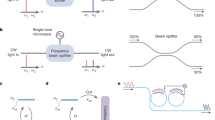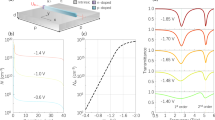Abstract
As the demand for high bandwidths in microelectronic systems increases, optical interconnect architectures are now being considered that involve schemes commonly used in telecommunications, such as wavelength-division multiplexing (WDM) and wavelength conversion1. In such on-chip architectures, the ability to perform wavelength conversion is required. So far wavelength conversion on a silicon chip has only been demonstrated using schemes that are fundamentally all-optical2,3,4,5,6, making their integration on a microelectronic chip challenging. In contrast, we show wavelength conversion obtained by inducing ultrafast electro–optic tuning of a microcavity. It is well known that tuning the parameters of an optical cavity induces filtering of different colours of light7. Here we demonstrate that it can also change the colour of light. This is an effect often observed in other disciplines, for example, in acoustics, where the sound generated by a resonating guitar string can be modified by changing the length of the strings (that is, the resonators)8. Here we show this same tuning effect in optics, enabling compact on-chip electrical wavelength conversion. We demonstrate a change in wavelength of up to 2.5 nm with up to 34% on–off conversion efficiency.
This is a preview of subscription content, access via your institution
Access options
Subscribe to this journal
Receive 12 print issues and online access
$209.00 per year
only $17.42 per issue
Buy this article
- Purchase on Springer Link
- Instant access to full article PDF
Prices may be subject to local taxes which are calculated during checkout





Similar content being viewed by others
References
Yoo, S. J. B. Wavelength conversion technologies for WDM network applications. J. Lightwave Technol. 14, 955–966 (1996).
Espinola, R. L., Dadap, J. I., Osgood, R. M. Jr, McNab, S. J. & Vlasov, Y. A. C-band wavelength conversion in silicon photonic wire waveguides. Opt. Express 13, 4341–4349 (2005).
Foster, M. A. et al. Broad-band optical parametric gain on a silicon photonic chip. Nature 441, 960–963 (2006).
Fukuda, H. et al. Four-wave mixing in silicon wire waveguides. Opt. Express 13, 4629–4637 (2005).
Jalali, B., Raghunathan, V., Dimitropoulos, D. & Boyraz, O. Raman-based silicon photonics. IEEE J. Sel. Top. Quant. Electron. 12, 412–421 (2006).
Xu, Q., Almeida, V. R. & Lipson, M. Micrometer-scale all-optical wavelength converter on silicon. Opt. Lett. 30, 2733–2735 (2005).
Vahala, K. J. Optical microcavities. Nature 424, 839–846 (2003).
Notomi, M. & Mitsugi, S. Wavelength conversion via dynamic refractive index tuning of a cavity. Phys. Rev. A 73, 051803 (2006).
Soref, R. A. & Bennett, B. R. Kramers–Kronig analysis of electro-optical switching in silicon. SPIE Integr. Opt. Circuit Eng. 704, 32–37 (1987).
Xu, Q., Schmidt, B., Pradhan, S. & Lipson, M. Micrometre-scale silicon electro-optic modulator. Nature 435, 325–327 (2005).
Preble, S. F. & Lipson, M. Conversion of a signal wavelength in a dynamically tuned resonator. Integrated Photonics Research and Applications Topical Meeting, IMC5 (2006).
Reed, E. J., Soljacic, M. & Joannopoulos, J. D. Color of shock waves in photonic crystals. Phys. Rev. Lett. 90, 203904 (2003).
Yanik, M. F. & Fan, S. Dynamic photonic structures: stopping, storage, and time reversal of light. Studies Appl. Math. 115, 233–253 (2005).
Almeida, V. R., Barrios, C. A., Panepucci, R. R. & Lipson, M. All-optical control of light on a silicon chip. Nature 431, 1081–1084 (2004).
Almeida, V. R. et al. All-optical switching on a silicon chip. Opt. Lett. 29, 2867–2869 (2004).
Yariv, A. Universal relations for coupling of optical power between microresonators and dielectric waveguides. Electron. Lett. 36, 321–322 (2000).
Preble, S. F., Xu, Q., Schmidt, B. S. & Lipson, M. Ultrafast all-optical modulation on a silicon chip. Opt. Lett. 30, 2891–2893 (2005).
Gaburro, Z. et al. Photon energy lifter. Opt. Express 14, 7270–7278 (2006).
Loncar, M., Hochberg, M., Scherer, A. & Yueming, Q. High quality factors and room-temperature lasing in a modified single-defect photonic crystal cavity. Opt. Lett. 29, 721–723 (2004).
Song, B.-S., Noda, S., Asano, T. & Akahane, Y. Ultra-high-Q photonic double-heterostructure nanocavity. Nature Mater. 4, 207–210 (2005).
Xu, Q., Manipatruni, S., Schmidt, B., Shakya, J. & Lipson, M. 12.5 Gbit/s carrier-injection-based silicon micro-ring silicon modulators. Opt. Express 15, 430–436 (2007).
Rong, H. et al. A continuous-wave Raman silicon laser. Nature 433, 725–728 (2005).
Acknowledgements
The authors acknowledge support by the Center for Nanoscale Systems, supported by the National Science Foundation. We thank Gernot Pomrenke from the Air Force Office of Scientific Research (AFOSR) for partially supporting this work. This work was performed in part at the Cornell Nano-Scale Science & Technology Facility (a member of the National Nanofabrication Users Network), which is supported by the National Science Foundation, its users, Cornell University and Industrial Affiliates.
Author information
Authors and Affiliations
Contributions
S.F.P. conceived the idea, performed measurements and drafted the manuscript. Q.X. supported discussion. M.L. contributed to the manuscript.
Corresponding author
Ethics declarations
Competing interests
The authors declare no competing financial interests.
Rights and permissions
About this article
Cite this article
Preble, S., Xu, Q. & Lipson, M. Changing the colour of light in a silicon resonator. Nature Photon 1, 293–296 (2007). https://doi.org/10.1038/nphoton.2007.72
Received:
Accepted:
Published:
Issue Date:
DOI: https://doi.org/10.1038/nphoton.2007.72
This article is cited by
-
Lead Selenide Thin Films Designed for Laser Sensing and Visible Light Communications
Silicon (2023)
-
Temporal loss boundary engineered photonic cavity
Nature Communications (2021)
-
Tailoring the properties of quantum dot-micropillars by ultrafast optical injection of free charge carriers
Light: Science & Applications (2021)
-
On-chip electro-optic frequency shifters and beam splitters
Nature (2021)
-
Broadband frequency translation through time refraction in an epsilon-near-zero material
Nature Communications (2020)



